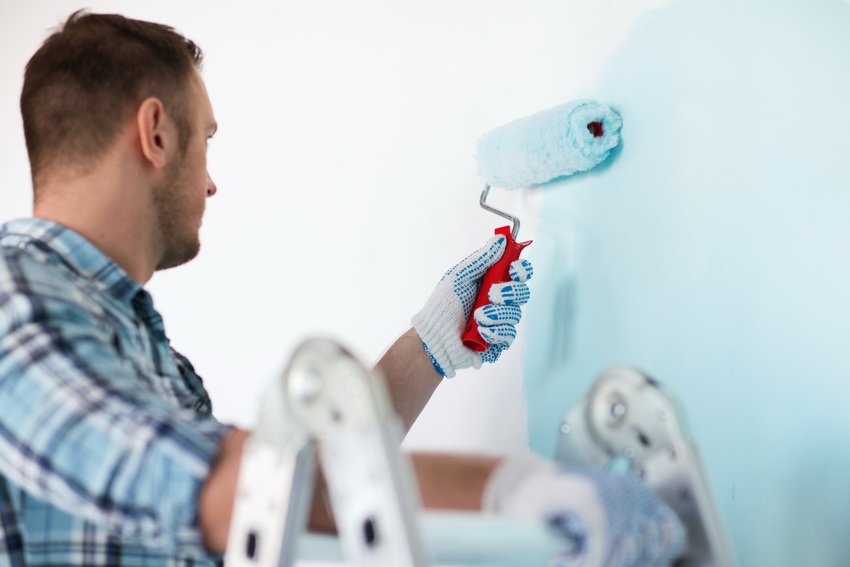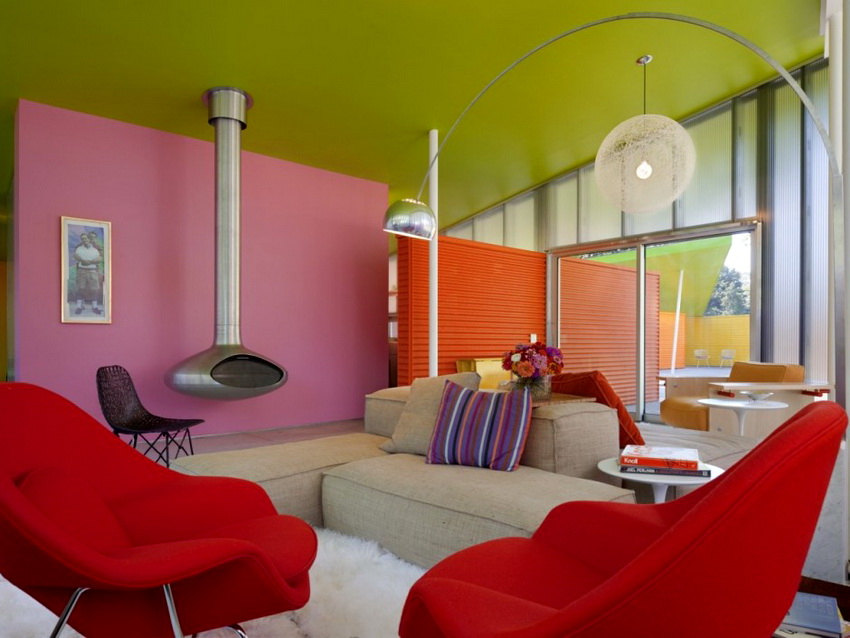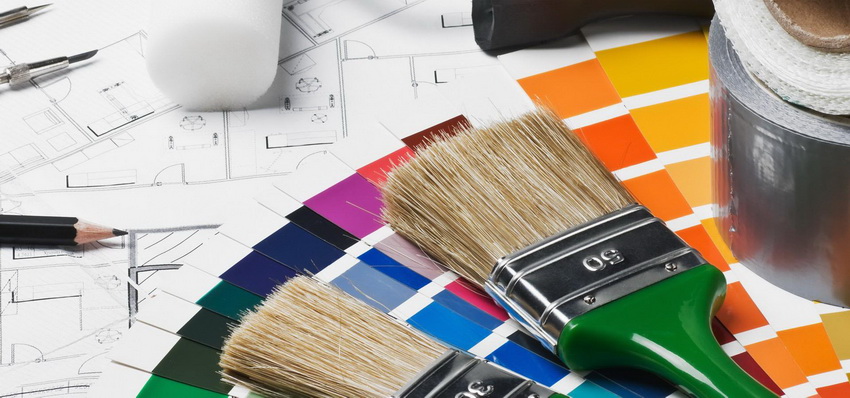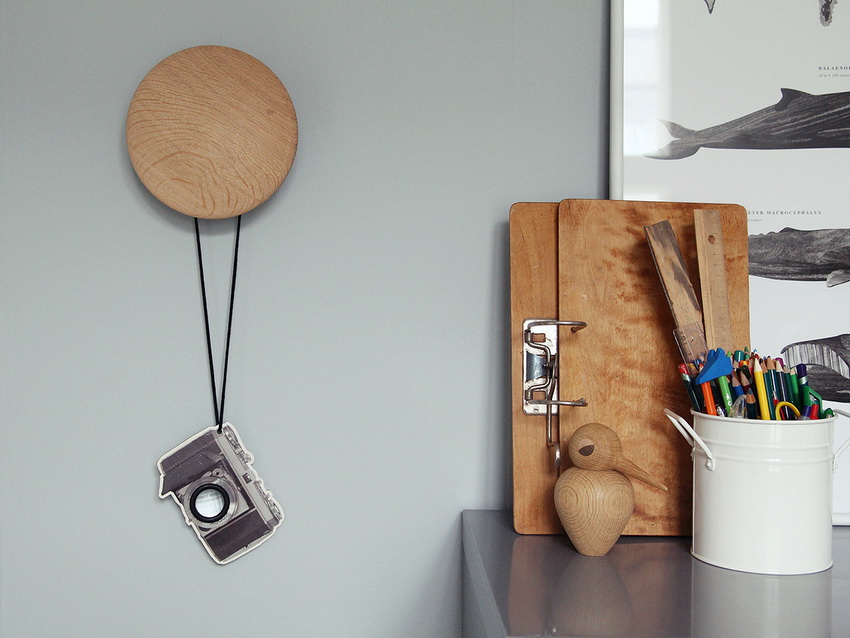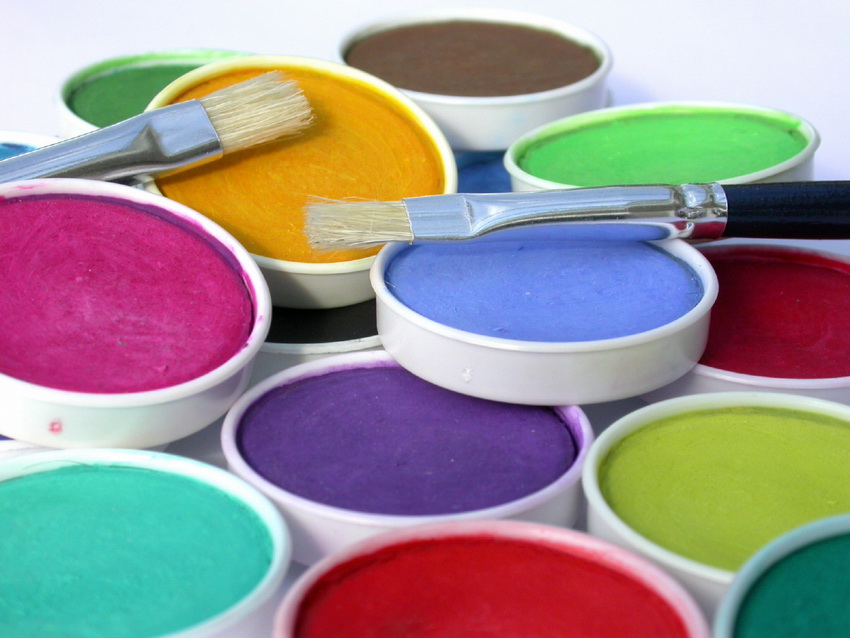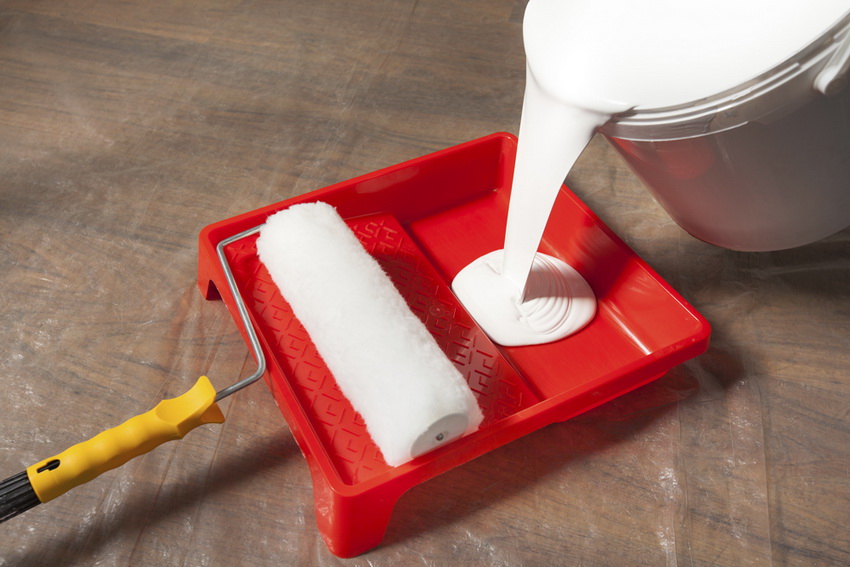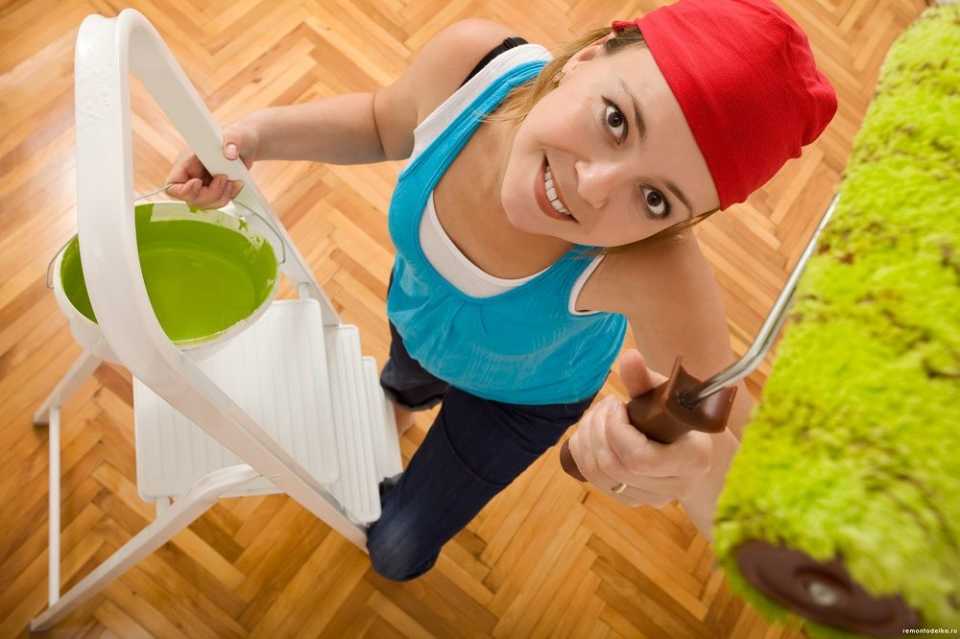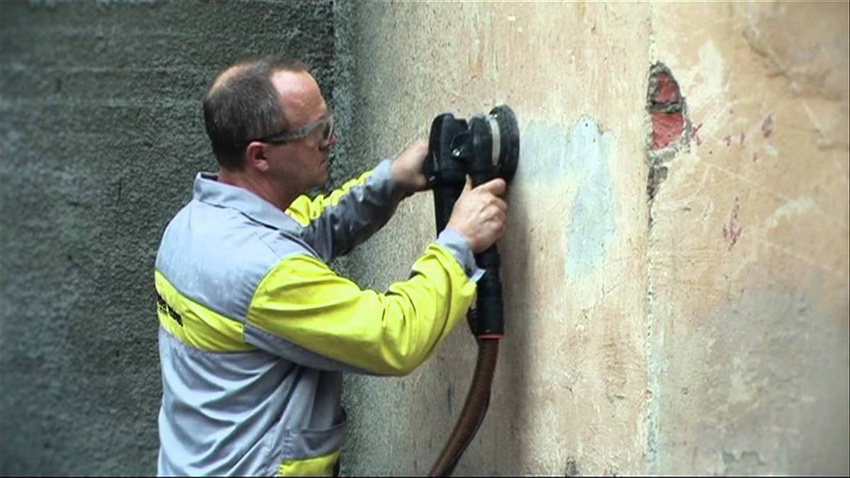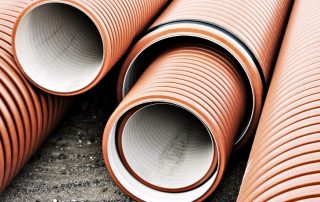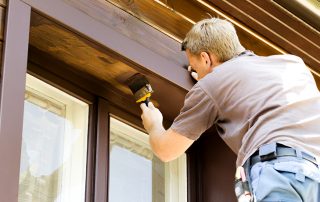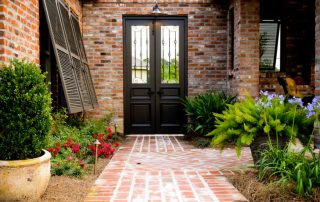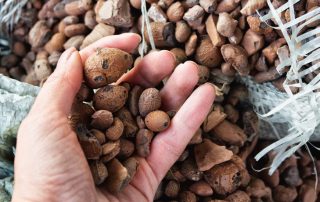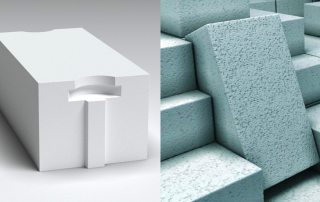From this article you can find out what water-based wall paint is and what capabilities it has. The text contains information on all types of water-based finishing materials, their technical characteristics and application features.
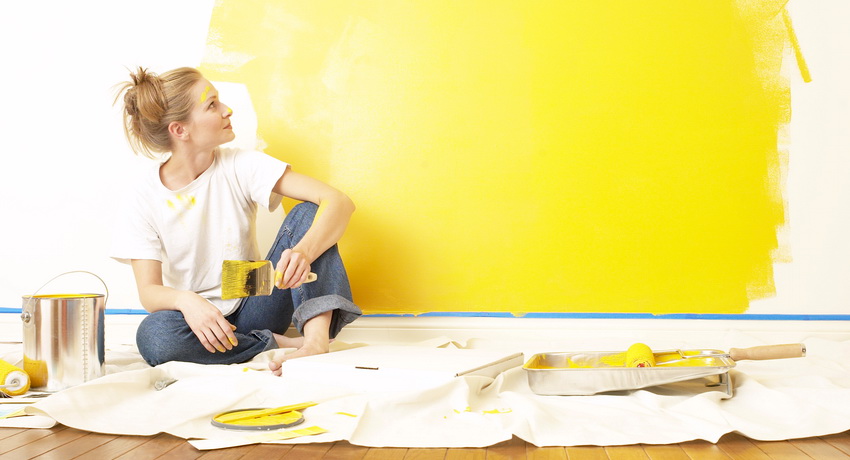
The possibilities of water-based paints allow you to create high-quality wall finishes inside and out
Content [Hide]
- 1 Water-based paint for walls: basic information about the group of compositions
- 2 Application of water-based paint: consumption, tinting, tools
- 2.1 Recommendations for the use of color for water-based paint
- 2.2 Calculation of the required volume of water-based paint, consumption per 1m2
- 2.3 How to paint walls with a roller: recommendations
- 2.4 Is it possible to glue wallpaper on water-based paint
- 2.5 Is it possible to paint with water-based paint on enamel
- 2.6 Is it possible to paint the ceiling with water-based paint over old paint
Water-based paint for walls: basic information about the group of compositions
Water-based paints are a broad category of materials for finishing various surfaces. To study these mixtures in a narrower sense, you should pay attention to their components, purpose and method of production. Complex names of chemical substances can be noticed in the composition of water-based dyes, but in simple language most of them sound like silicone, PVA glue, chalk, etc. Each type of dye from this category has its own advantages and disadvantages, which depend on the components.
These dyes are based on water, which contains tiny particles of polymer substances. The type of paint depends on the nature of these substances. In addition, the composition contains additional components. Manufacturers use these elements to endow the finishing material with useful properties and improve its performance.
The composition of water-based dyes may contain the following components:
- defoamers;
- antiseptic agents;
- plasticizers;
- fungicidal substances;
- dispersants;
- antifreeze substances.
The proportions of components in the composition of water-based paints for interior work
An emulsifier or film former is the main constituent of water-based dyes. The scope of application of the finishing material depends on the type of emulsifier.
The following are used as emulsifiers:
- styrene butadiene;
- acrylate;
- polyvinyl acetate or, in other words, PVA;
- styrene acrylate.
Dye labeling directly depends on the type of film former. Additionally, the compositions are filled with mica, chalk, talc, barite. Each of these components can be present in the composition alone or together with others in a different proportional ratio. Carboxymethyl cellulose is used as a thickener. This component also has a second name - the adhesive composition of the CMC.
Helpful advice! Experts recommend to buy when working with water-based paint spray gun for high-quality and uniform coating.
The percentage of the components of the water-based paint:
| Component | The percentage in the dye,% |
| Polymer in aqueous solution (dispersion) | 50-60 |
| Coloring pigments and fillers | 35-40 |
| Thickeners and plasticizers | 5-8 |
| Additional components | 1-7 |
White water-based paint is obtained by adding a white pigment, for example, zinc oxide or titanium dioxide, to the composition. All existing types of water-based dyes are labeled according to the type of emulsifier.
The following types of materials are distinguished:
- silicate;
- acrylic;
- silicone;
- mineral.
Many buyers are interested in how acrylic paints differ from water-based compositions. The usual water-based mixture is completely unsuitable for finishing metal surfaces. For these purposes, it is better to take an acrylic material that is heat and water resistant.
Main markings of water-based paints, GOST
In stores you can find an extensive selection of paints and varnishes from different companies. Therefore, before buying a water-based paint, you must carefully study the technical characteristics and markings. These notes allow you to get an idea of what components the mixture includes, what are its properties and scope.
The first value marks the type of composition:
- VE - water-based paint.
- VD - water-dispersed.
Further, the manufacturer places information on the type of polymer substance used as a basis for the production of the dye.
The following types of markings on packaging are distinguished by the type of polymer:
- CS (styrene butadiene);
- VA (polyvinyl acetate);
- AK (acrylate or styrene acrylate);
- ВС (polyvinyl alcohol).
The number "1" marks the front water-based paints, the price of which is much higher than for conventional compositions. These mixtures are resistant to all atmospheric phenomena: precipitation, low temperatures, climatic changes, the influence of ultraviolet radiation and microorganisms. The average cost for a volume of 2.7 liters for the example of Tikkuril products is 770 rubles.
The number "2" indicates a formulation intended for internal use. Thus, interior water-based paints for the ceiling and walls are marked. A similar volume of Tikkuril mixture for internal use costs about 450 rubles.
When choosing a dye, regulatory documents are also important. According to GOST number 281960-89, a dye made in full compliance with its requirements is considered to be of high quality.
Important! Technical specifications have been significantly reduced. Therefore, a dye made in accordance with its standards cannot be considered of high quality.
Technical characteristics of VEAK 1180 water-based paint
This type of dye is popular with consumers. The "VE" mark indicates that the composition is based on an aqueous emulsion. The role of a polymer emulsifier responsible for film formation is acrylic or substances that are its derivatives. This is evidenced by the marking "AK".
Technical indicators of VEAK 1180 water-based paint:
| Characteristic | Value |
| Frost resistance degree, number of cycles | 4-5 |
| Conditional viscosity index, s | 20-42 |
| Drying rate of the coating, h | 15 |
| The amount of non-volatile substances,% | 60 |
| The amount of consumption of water-based paint per 1 m2, g | 160 |
Such indicators are more applicable to the performance of interior painting work on finishing the ceiling and walls. The dye adheres perfectly to the previously prepared substrate.
This composition allows the processing of the following types of surfaces:
- concrete;
- plastered base;
- brickwork;
- metal (subject to prior application of a primer).
The basic color base for VEAK 1180 is white. If desired, the customer can add coloring pigments to the composition to obtain any desired color. The average cost of 1 kg of dye is about 500 rubles.
Application of water-based paint: consumption, tinting, tools
There are two variants of coloring pigments in stores: natural and artificial. When using natural pigment, the result will be more saturated, but there is a possibility that the shade of the coating will quickly fade under the influence of ultraviolet radiation. For this reason, the use of a natural color scheme will be advisable in rooms where direct sunlight does not penetrate. Artificial pigments are not so bright, but they show high resistance to ultraviolet light.
It is very difficult to achieve the desired shade at home, so it is better to seek help from specialists. Having chosen the shade you like according to the palette that is in every store, you can perform tinting using a special machine.
Recommendations for the use of color for water-based paint
If desired, the tinting of the composition can be done independently. Most often, this procedure is resorted to in order to save money. The cost of white paint and a set of pigments is much lower than the price of a tinted composition. By experimenting at home, you can achieve the desired color depth. In addition, in the photo, the color of the color scheme for water-based paint will not always correspond to what will be obtained as a result of mixing in a car.
In order not to overdo it, the coloring pigments should be introduced into the composition gradually until the color becomes uniform. In this case, the mixture must be stirred all the time.
Helpful advice! It is extremely difficult to achieve the same shade again, therefore it is recommended to calculate in advance the estimated volume of consumption of water-based paint with a small margin and prepare the required portion at a time.
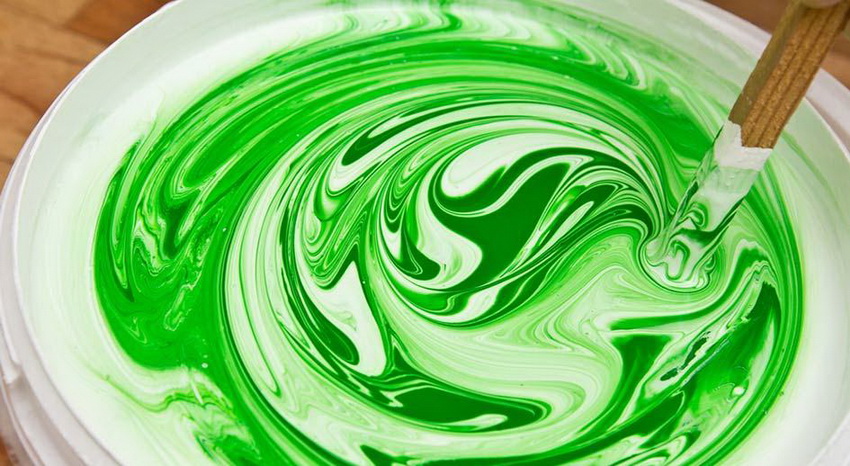
When self-tinting paint, it is worth distributing the amount of material so that it is enough for the entire amount of work
You can carry out a trial tinting on a small volume to study the properties of the color After that, testing is performed on an inconspicuous section of the wall. You should wait until the composition is completely dry for the color to appear. This takes 1-2 days.
For small rooms, it is recommended to select shades of light colors. They can visually expand the space. If the walls in the room are dark and the ceiling is light, the room, on the contrary, will appear narrower. This method is used when you need to visually raise the height of the ceilings. It is better if the design contains no more than three colors. This will avoid variegation. The exceptions are white and black, as well as shades of the same color.
Calculation of the required volume of water-based paint, consumption per 1m2
The consumption rate of the dye is usually indicated by the manufacturer on the packaging. These data help to roughly determine how much compound will be required to finish a certain area.
General consumption rates for water-based dyes:
| Type of water-based dye | Consumption during the initial application, g / m2 | Consumption on the second layer, g / m² |
| Latex | 600 | 400 |
| Silicone | 300 | 150 |
| Silicate | 400 | 350 |
| Acrylic | 250 | 150 |
| Polyvinyl acetate | 550 | 350 |
Additional factors can also affect the consumption of water-based paint per 1 m². For example, the structure of the treated surface. To paint smooth plaster, you will need 10-20% less dye than to process textured material. When calculating, the indicators for the first and second layers are summed up. In addition, one should take into account the method of applying the composition and the features of the tool that will be used.
Climatic conditions can also affect consumption and quality. In the heat, the water from the composition quickly evaporates, so the coating may turn out to be uneven. In this case, you will need to level the surface, and sometimes tint the spots. Wallpaper for painting will require an increase in the rate by about 20%. The paper has a porous structure, so it will absorb part of the composition. About 5% of the paint is lost during the processing of the ceiling, flowing down to the floor.
How to paint walls with a roller: recommendations
It is not recommended to use a brush for painting surfaces with water-based paint. The use of this tool will increase consumption. Most often, a roller with a tray is taken for such work. In this case, the consumption of the dye, as well as the decorative characteristics of the coating, will depend on the material and coat of the tool. A long-nap roller is best used for finishing stucco and rough surfaces. For dyeing smooth surfaces, use a short-grain tool.
Helpful advice! The use of a spray gun for water-based paint will significantly reduce the consumption of the composition. This tool is considered the most economical and suitable for this type of work.
Recommendations for painting walls with a roller:
- the size of the tray must be selected so that the tool fits freely in it;
- the roller should be immersed no more than a quarter into the paint;
- during staining, you need to press the roller with the same force, passing over the entire surface in order to exclude stripes and stains;
- water can be added to dilute thick paint, but not more than 10%;
- you should not dip the roller often, the coating should turn out to be thin and smooth;
- you do not need to try to apply the dye in a thick layer to reduce the work, this will lead to overspending and the appearance of cracks in the coating;
- it is necessary to take breaks between layers (at least 2 hours) so that the dye dries.
Is it possible to glue wallpaper on water-based paint
Water-based paint is a versatile type of material that can be combined with different types of surfaces. Often there is a need to change the design of a previously painted room, for example, to glue wallpaper. This option for replacing the finish is possible, but subject to preliminary preparation of the base. For this, the wall surface is treated with a solution consisting of glue and soil. The components are mixed in a 1: 1 ratio.
Wallpaper can be glued over a water-based dye, provided that the previous coating is made with a high-quality composition and without breaking technology.
Note! Before you start gluing wallpaper, you should check the adhesive properties of the dye (the reliability of fixing the coating). To do this, an ordinary newspaper is glued to the wall and, after drying, comes off from the wall. If it is difficult to detach, it means that the cover is holding strong enough to support the weight of the wallpaper.
Is it possible to paint with water-based paint on enamel
Sometimes there is an old coating on the wall, usually in the form of oil paint. These compounds used to be very popular, so they were almost universally used in homes as decoration. Since these materials are incompatible, the old coating will need to be removed.
How to remove old paint from walls:
- Removal by mechanical means.
- Chemical dissolution.
- Elimination of the coating using temperature exposure.
Enamel is much easier. In order for the water-based paint to lay on top of the enamel, matting or a primer should be applied. The matting effect is achieved by applying drying oil, although this method also has a drawback - an unpleasant pungent odor.
Related article:
Paint for walls in an apartment: properties, types and recommendations for use
Advantages and disadvantages of this type of coating, varieties and features of the compositions, prices. Recommendations for choosing a dye and optimal color gamut.
Alternatively, you can apply mechanical surface treatment with fine-grained emery paper. This will increase the degree of adhesion. The primer performs a similar function.
Is it possible to paint the ceiling with water-based paint over old paint
In order to determine the possibility of painting with water-based paint over the old coating, you need to assess its condition and prepare the surface. The dye will not be able to hide all defects, especially if defects are present on an obsolete paint and varnish layer. All irregularities and damage, on the contrary, will become visible and catchy. As a result, all work, like the money spent on buying paint, will be wasted.
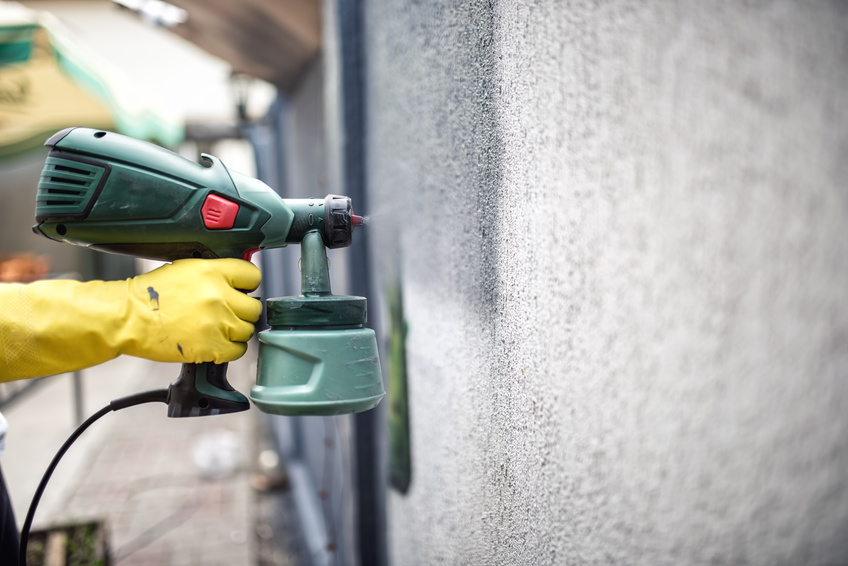
Using a spray gun will significantly reduce paint consumption and will be useful when painting large areas
If the surface is smooth and free of serious imperfections, it is recommended to apply a primer before painting. If the old coating peels off, the base should be well cleaned in problem areas. It is not allowed to apply water-based dye over old lime whitewash. In this case, remove the coating and rinse the base with an alkaline water solution.
Water-based formulations are the most convenient and practical types of dyes. Due to the wide assortment, buyers do not have any problems with the choice of finishing materials for interior or exterior work.
